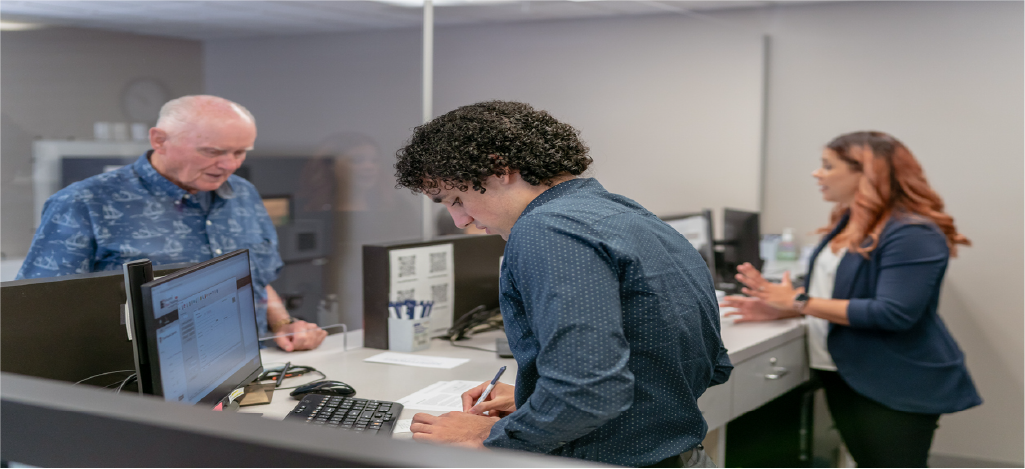Discover the ins and outs of medical billing clearinghouses in this comprehensive guide.
In the complex world of healthcare administration, one term that often comes up is a medical billing clearinghouse. But what exactly is a medical billing clearinghouse and what role does it play in the healthcare industry? In this comprehensive guide, we will explore the definition and function of a medical billing clearinghouse, how it facilitates the process of medical billing, the benefits of using a clearinghouse, factors to consider when choosing the right clearinghouse, and common misconceptions surrounding these entities.
Understanding Medical Billing Clearinghouse

When it comes to the complex world of medical billing, a key player that often goes unnoticed is the medical billing clearinghouse. This unsung hero acts as an intermediary between healthcare providers, such as doctors, hospitals, and clinics, and insurance payers, including private insurance companies, Medicare, and Medicaid. But what exactly does a medical billing clearinghouse do, and why is it so important?
Definition and Function of a Medical Billing Clearinghouse
At its core, a medical billing clearinghouse serves as a vital link in the chain of healthcare reimbursement. Its primary function is to transmit electronic claims and related documentation from healthcare providers to payers for reimbursement. In simpler terms, it takes the burden off healthcare providers by handling the tedious task of submitting claims to insurance companies.
Before the advent of electronic claims submission, healthcare providers had to deal with piles of paperwork and lengthy manual processes to submit claims to insurance companies. This archaic system was not only time-consuming but also prone to errors and rejections. However, the emergence of medical billing clearinghouses revolutionized this process by streamlining and automating the transmission of claims.
By leveraging advanced technology and sophisticated software systems, medical billing clearinghouses have made the lives of healthcare providers significantly easier. They act as a bridge, seamlessly connecting healthcare providers with insurance payers, ensuring a smooth flow of information and facilitating timely reimbursements.
The Role of a Clearinghouse in Healthcare
Now that we understand the basic function of a medical billing clearinghouse, let's dive deeper into its role in the healthcare industry.
One of the most crucial roles played by a medical billing clearinghouse is ensuring accurate and timely reimbursement for healthcare providers. How do they achieve this? By acting as a central hub, the clearinghouse standardizes and validates claims data before submission to payers. This meticulous process helps reduce errors and minimize rejections, ultimately speeding up the reimbursement process.
But that's not all! Medical billing clearinghouses offer a range of additional services that further enhance the efficiency and effectiveness of the medical billing process. For example, they provide eligibility verification, which allows healthcare providers to determine whether a patient's insurance coverage is active and valid. This feature helps prevent claim denials due to invalid insurance information.
Another valuable service offered by clearinghouses is claim tracking. With this feature, healthcare providers can easily monitor the progress of their claims, ensuring that nothing falls through the cracks. This real-time visibility allows for proactive follow-up and resolution of any issues that may arise during the reimbursement process.
Lastly, medical billing clearinghouses provide electronic remittance advice (ERA) retrieval. ERAs are electronic statements that provide detailed information about the payment or denial of a claim. By retrieving ERAs electronically, healthcare providers can quickly and accurately reconcile their accounts, reducing the need for manual data entry and minimizing potential errors.
In summary, medical billing clearinghouses are the unsung heroes of the healthcare industry. They simplify and streamline the complex process of medical billing, ensuring accurate and timely reimbursement for healthcare providers. By acting as intermediaries between healthcare providers and insurance payers, clearinghouses play a vital role in maintaining the financial health of healthcare organizations and allowing them to focus on what truly matters – providing exceptional patient care.
The Process of Medical Billing Through a Clearinghouse
Medical billing is a complex process that involves various steps to ensure accurate and timely reimbursement for healthcare providers. One crucial aspect of this process is the involvement of a clearinghouse, which acts as an intermediary between the healthcare provider and the payer. Let's delve deeper into the intricacies of medical billing through a clearinghouse.
Submitting Claims to a Clearinghouse
The initial step in medical billing through a clearinghouse is the submission of electronic claims by the healthcare provider. These claims contain crucial information, including patient demographics, diagnosis codes, procedure codes, and supporting documentation. This data is vital for the payer to assess the validity and appropriateness of the claim.
Upon receiving the claim, the clearinghouse undertakes a comprehensive review to ensure its completeness and accuracy. The clearinghouse performs various checks to ensure compliance with industry standards and payer-specific requirements. These checks include verifying the accuracy of the diagnosis and procedure codes, confirming that the patient information is complete and up-to-date, and checking for any missing or erroneous data.
If any errors or missing information are identified during the review process, the clearinghouse promptly communicates these issues back to the healthcare provider. This feedback allows the provider to make the necessary corrections and resubmit the claim, ensuring that it meets all the necessary requirements for successful processing.
How Clearinghouses Interact with Payers
Once the claim passes the clearinghouse's validation checks, it is electronically transmitted to the appropriate payer. Payers can be private insurance companies or government programs such as Medicare or Medicaid. The clearinghouse acts as a vital link between the healthcare provider and the payer, facilitating the secure exchange of claims data.
The electronic transmission of claims expedites the processing and adjudication of claims, leading to faster reimbursements for healthcare providers. By leveraging technology, clearinghouses enable seamless communication between providers and payers, reducing the administrative burden and streamlining the overall billing process.
Clearinghouses play a crucial role in ensuring that claims are accurately and efficiently processed. They have established connections with various payers, allowing them to transmit claims electronically and receive timely responses. This electronic exchange of data eliminates the need for manual paperwork and reduces the chances of errors or delays in the billing process.
Furthermore, clearinghouses also provide additional services to healthcare providers, such as eligibility verification and claim status inquiries. These services help providers stay informed about the progress of their claims and ensure that they meet all the necessary requirements for successful reimbursement.
In conclusion, medical billing through a clearinghouse involves the submission of electronic claims, thorough reviews for accuracy and completeness, and the secure transmission of claims data to payers. Clearinghouses streamline the billing process, leading to faster reimbursements and improved efficiency for healthcare providers.
Benefits of Using a Medical Billing Clearinghouse

Efficiency and Accuracy in Billing
One of the significant benefits of using a medical billing clearinghouse is the efficiency and accuracy it creates. By automating the submission of claims and conducting comprehensive validation checks, clearinghouses reduce errors and improve the chances of claims being reimbursed on the first submission.
The streamlined workflow provided by clearinghouses frees up valuable time and resources for healthcare providers. This allows providers to focus on their core task of patient care.
Streamlining the Reimbursement Process
Clearinghouses play a vital role in streamlining the reimbursement process. By electronically transmitting claims to payers, they eliminate the need for manual paperwork and mailing, reducing both time and costs.
They also often provide tools and reports that enable healthcare providers to track the status of their claims. This ensures transparency and enables proactive follow-up on any pending or rejected claims.
Choosing the Right Medical Billing Clearinghouse
Key Features to Look for in a Clearinghouse
When selecting a medical billing clearinghouse, it's essential to consider key features that align with your specific needs. Look for clearinghouses that offer robust claim scrubbing capabilities, extensive payer connectivity, HIPAA compliance, and reliable customer support.
Furthermore, integration capabilities with your existing practice management or electronic health record (EHR) system are essential for seamless data exchange and workflow integration.
Evaluating the Cost and Value of a Clearinghouse
Cost is an important factor to consider when choosing a medical billing clearinghouse, but it shouldn't be the sole determining factor. Evaluate the overall value the clearinghouse provides, such as the additional services mentioned earlier, as well as the potential for improved billing accuracy and reimbursement rates.
Consider factors like the clearinghouse's track record, user reviews, and the level of support they offer in terms of training and ongoing technical assistance.
Common Misconceptions About Medical Billing Clearinghouses

Clearing Up Confusion About Clearinghouses
There are several misconceptions surrounding medical billing clearinghouses, and it's essential to clear up these misunderstandings. One common misconception is that clearinghouses are responsible for claim denials. While a clearinghouse may flag errors, it's the payer who makes the decision to deny or reimburse a claim.
Debunking Myths About Medical Billing Clearinghouses
Another myth is that using a medical billing clearinghouse is cost-prohibitive for small healthcare practices. However, many clearinghouses offer pricing models tailored to the needs of smaller providers, making their services accessible and affordable.
It's crucial to separate fact from fiction to understand the role and benefits of medical billing clearinghouses in today's landscape.
In conclusion, a medical billing clearinghouse serves as a vital intermediary between healthcare providers and insurance payers, facilitating the efficient and accurate transmission of claims. Clearinghouses contribute to enhanced billing efficiency and improved financial outcomes for healthcare providers. When choosing a clearinghouse, it's important to consider the key features, cost, and value they bring. Lastly, it's critical to debunk common misconceptions surrounding clearinghouses to fully grasp their role and benefits in the healthcare industry.
Going Forward with BillFlash
With BillFlash, practices can go further by optimizing their revenue cycle, efficiently collecting past-due A/R, and providing patients with a convenient and secure payment experience. With a user-friendly interface and industry experts available for all your billing, payments and collections needs, BillFlash is the perfect solution for small practices.

